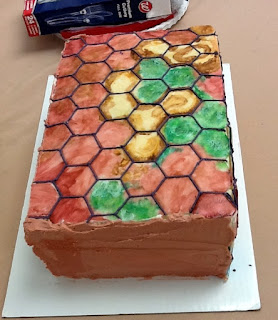Today a follow up on our local Battletech sessions. We had been playing through the Sword and Dragon Starterbook scenarios, and this past Wednesday we finally finished the last scenario:
Dust Up. I
wrote about these sessions over a year ago, and despite the problems we managed to soldier through to the final mission. Our group is very persistent about playing scenario packs through to the end.
No, we haven't been playing these the whole time, we took several breaks, the most recent from mid-November to the start of this final mission, which played out these past three weeks. In the interim we played a few
Grinders and some scenarios out of
Tales of the Black Widow Company. I know I was
critical of the Sword and Dragon scenarios, but it anything some of these TBWC scenarios are worse. But I digress.
In the course of the Sword and Dragon scenarios we made a few discoveries that are worth sharing (I hope).

Who won the final battle? Technically McKinnon's Raiders, but it was never a fair fight, and the Sabres make a good show of it. The bias towards the Davion forces, primarily in pilot skills and abilities was apparent from the beginning and carried through to the final mission. This helped the Raiders come out a little ahead on WP after every mission, leading to bigger and better mechs much sooner than the Sabres, and magnifying the advantage.
Some of the more powerful pilot abilities that make the characters so special might be fun once, or even occasionally, but used all the time are just silly. We got the feeling the S&D book was written by people who only play Battletech a few times a year, rather than by anyone who actually plays on a regular basis. Battletech should always be about the mechs, with only a very few pilots that really stand out. A single company where half the pilots have outrageously useful special abilities was a bad idea.

Those quirky mechs in the books, the ones that malfunction in such interesting ways, were the first things we sold off. If your want to write a scenario book with quirky mechs, some of those quirks must be worth keeping around. The most obvious way to do this would be to tie some of the pilot abilities to only work in combination with their quirky mechs. This would have helped with some of the game balance issues too.
When the player forces (McKinnon's Raiders or Sorenson's Sabres) are up against a randomly determined OpFor, it's usually a very one sided battle. Often the best the OpFor player can do is try to get some damage on every player mech, forcing them to spend more Warchest Points for repairs, and slowing their progress in future missions. This sort of game might be OK to introduce new players to the game in a scenario they can win, but new players on the OpFor side are going to get bored and quit. In our group of veteran players, it was sometimes a challenge to see how you could do in a losing effort. Other times we played crazy-aggressive, charging forward into fire in an effort to end the scenario quickly.

That's not to say the players
always win. In several battles the OpFor was able to pull out a victory by luck or choosing the scenario setup to be especially difficult for the player force. In one particularly memorable defeat, our augmented recon lance (6 mechs) got their asses handed to them after the OpFor rolled 4 assault mechs, 2 heavies, and with veteran skills. If the post game discussion we determined that even our heaviest mechs might not have won.
In between scenarios we always had enough WP for repairs, and generally enough left over for a little new equipment or mechs. What both teams had trouble with was pilot hits. Pilots heal one hit if they sit out for a scenario, but after playing 3-4 missions we started to accumulated many injuries, and running out of healthy pilots. Our solution was to hire extra pilots and outfit a replacement lance with salvaged mechs, giving the regular pilots more time off. Even this wasn't enough, and after out summer break to play the "historical" scenarios from the new map pack, our GM declared all pilots to be fully healed.

That wasn't the only problem with pilot hits, over time there were casualties. The characters/pilots Daniel Sorenson AND Ian McKinnon (both Company commanders) died; taking kicks to the head after their mechs had fallen. After McKinnon's death, for obscure reasons, the Raider's were renamed "Lenny's Lemmings".

Despite the problems I keep rumbling on
(and on and on ...) about, one good thing that has come of this. We have nearly twice the number of regular players attending the weekly games now as we had a year ago. I think the focus on (mostly) old school Battletech has brought a lot of players back, and it's certainly nice to see the
Singapore Longshoremen back up to full unit strength.
Later this month we begin playing the
Wolf and Blake Starterbook, and we are already making plans to correct many of the problems we had with Sword and Dragon. Look for some posts on this topic in the coming months.


























